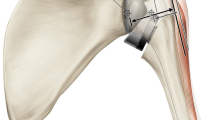Abstract
We describe our experience with a new system of patient-specific template called Personal Fit®, which is unique in shoulder surgery and used in combination with Duocentric® prosthesis. The reverse prosthesis’s concept is the invention of Paul Grammont, developed with Grammont’s team of Dijon University as from 1981, which led to the first reversed total shoulder prosthesis called Trumpet in 1985. The Duocentric® prosthesis developed in 2001 is the third-generation prosthesis, coming from the Trumpet and the second-generation prosthesis Delta® (DePuy). This prosthesis provides a novel solution to the notching problem with an inferior overhang integrated onto the glenoid baseplate. Personal Fit® system is based on reconstructing the shoulder joint bones in three dimensions using CT scan data, placing a landmark on the scapula and locating points on the glenoid and humerus. That will be used as a reference for the patient-specific templates. We study the glenoid position planned with Personal Fit® software relative to native glenoid position in 30 cases. On average, the difference between the planned retroversion (or anteversion in one case) and native retroversion was 8.6°.
























Similar content being viewed by others
References
Grammont P, Trouilloud P, Laffay JP, Deries X (1987) Study and production of a new shoulder prosthesis. Rhumatologie 39:17–22 (Article in French)
Grammont P, Baulot E (1993) Delta shoulder prosthesis for rotator cuff rupture. Orthopedics 16:65–68
Kany J, Gonzalvez M, Trouilloud P, Baulot E, Handelberg F (2008) Predictive factors for the occurrence of notching in reverse total prosthesis. 82th annual meeting of the S.O.F.C.O.T (Abstract in French)
Nyffeler R (2010) Personal experiences with inverse shoulder arthroplasty. Lead Opin Orthop Rheumatol 4
Zumstein A, Pinedo M, Old J, Boileau P (2011) Problems, complications, reoperations, and revision in reverse total shoulder arthroplasty: a systematic review. JSES 20(1):146–157
Smith D, Guyver T, Bunker TD (2012) Indications for reverse shoulder replacement. JBJS (Br) 94-B(5):577–583
Baulot E, Bouacida A, Labattut L, Trouilloud P (2011) Glenoid fixation and scapular pillar notching in reverse shoulder arthroplasty: radiology results with an average 10-year follow-up of the Delta prosthesis. Rev Chir Orthop 97(suppl no 7):S291 (Abstract in French)
Baulot E, Trost O, Demangel A, Trouilloud P (2006) Scapular neck: myth or reality? Application to glenoid cavity surgery. Morphologie 90:289 (Article in French)
Mole D, Favard L (2006) Eccentric glenohumeral OA. Symposium, 80th annual meeting of the S.O.F.C.O.T (Article in French)
Favard L, Oudet D, Huguet D, Sirveaux F, Mole D (2008) Results of anatomical and reverse prostheses for eccentric glenohumeral OA. Instructional courses, 82th annual meeting of the S.O.F.C.O.T (Article in French)
Augereau B (2010) Total prosthesis for degenerative shoulder pathologies. E-Mémoires de l’Académie nationale de chirurgie 9(2):69–75 (Article in French)
Valenti PH, Katz D (2005) How to implant a reverse shoulder prosthesis. Maitrise Orthopédique No. 148 (Article in French)
Valenti PH (2009) Unstable reverse prosthesis: diagnosis, treatment, prevention. Venus Course, Lorient (Article in French)
Frankle MA, Teramoto A, Luo ZP, Levy JC (2009) Glenoid morphology in reverse shoulder arthroplasty; classification and surgical implication. J Shoulder Elbow Surg 18(6):874–885
Landau JP, Hoenecke HR (2009) Genetic and biomechanical determinants of glenoid version: implications for glenoid implant placement in shoulder arthroplasty. J Shoulder Elbow Surg 18:661–667
Conflict of interest
No funds were received in support of this study. The authors, except P. Martz, are designers and inventors of the Duocentric® reverse prosthesis.
Author information
Authors and Affiliations
Consortia
Corresponding author
Rights and permissions
About this article
Cite this article
Trouilloud, P., Gonzalvez, M., Martz, P. et al. Duocentric® reversed shoulder prosthesis and Personal Fit® templates: innovative strategies to optimize prosthesis positioning and prevent scapular notching. Eur J Orthop Surg Traumatol 24, 483–495 (2014). https://doi.org/10.1007/s00590-013-1213-2
Received:
Accepted:
Published:
Issue Date:
DOI: https://doi.org/10.1007/s00590-013-1213-2



